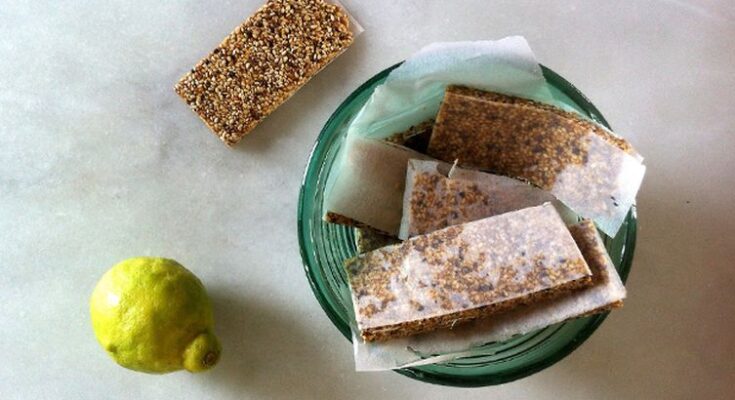
Pasteli (παστέλι) the ancient Greek dessert, has very few ingredients, but it has a great deal of history behind it.
A very ancient sweet indeed, it is a symbol of fertility and love; its recipe is traditional but still differs according to region.
By Giorgio Pintzas Monzani
In this fourth article in this series, we continue to retrace the journey of Greek cuisine and the effect it has had on culture the world over.
According to historical sources, the name of pasteli is derived from the ancient verb πασσω (paso), which means to sprinkle. This is, of course, inherent to the techniques involved in its preparation.
The first thing we know about this iconic Greek sweet is that it dates back to the Homeric era. In the Odyssey and in the Iliad, a sweet called ιτριον (itrion) is mentioned. A dish made of honey and sesame, it was used to give energy to Greek warriors who were battling in the Trojan War.
Even after Homeric times, it was recognized as a common meal amongst the Spartan military ranks before each battle.
A very different symbology from that of war began to be associated with the sweet with the arrival of the golden age of Athens toward the end of the sixth century BC, a period of great cultural growth in the Greek world.
In fact, the historian Herodotus, who is considered “The Father of History,” spoke in the fifth century BC about a dessert made of honey and sesame in the form of a kind of flat bread to be broken with the hands by young people at parties and dances.
This custom later became a recognized ritual in Greek weddings in which the bride and groom were offered cakes, always to be eaten as finger food. The honey symbolized love and passion whereas sesame recalled the seed of life, or fertility.
Incredibly, even to this day, the custom of eating pasteli as part of the wedding ritual remains, especially on the islands of the Aegean Sea.
The many variations of pasteli today
Nowadays, it is possible to find many variations of pasteli, which has survived the test of time throughout the millennia, in different flavors and consistencies.
In the northern part of Greece, pasteli is likely to have a crispier texture thanks to the use of sugar in addition to honey, which, once crystallized, gives this characteristic to pasteli. In the southern part of the country, only honey is still used for a softer texture.
In order to enrich pasteli’s base of honey and sesame, many variants also add dried fruits, such as hazelnuts, almonds, and raisins.
Even in terms of taste, however, the sweet can vary according to the region. For example, on the island of Rhodes, pasteli is instead known as μελεκουνι (melekuni). It is spicier and fruitier with the addition of orange peel.
On Amorgo, the custom calls for pasteli to be wrapped in lemon leaves after cooking in
order to give it a distinct aroma.
On Sifanto, the difference is in the preparation. As opposed to other regions and areas, on the southern Aegean island, it is not used to foam honey during boiling.
Today, I will share a recipe without the addition of sugar but with a condiment that will make your friends and relatives go crazy when they taste it.
Pasteli with Acacia honey, hazelnuts, pepper, raisins and yellow peaches
Ingredients:
● 500 gr Acacia honey
● 500 gr white sesame
● 80 gr hazelnuts
● 1 yellow peach
● 80 gr raisins
● pinch of pepper
Or, in imperial measurements:
1/2 cup of white sesame
1/2 cup of honey
1 yellow peach
1/2 cup of raisins
1/2 cup of hazelnuts
pinch of pepper
Directions:
In a baking dish lined with parchment paper, lightly toast the sesame seeds at 150 degrees Celsius (300 degrees F) in the oven, being careful not to burn the seeds.
Cut the peaches into small cubes, about 1/2 inch.
In a saucepan with a thick bottom, add the honey to heat over medium-low. Once it begins to boil, remove the foam with a sieve and then lower the flame slightly and allow it to continue cooking for 6 to 7 minutes.
Then, add the sesame, raisins, chopped hazelnuts, peaches, and pepper.
We allow the mixture to remain on medium low heat for a few more minutes.
To make sure it’s ready to be rolled out, we take a teaspoon of it and dip it in cold water; if it doesn’t melt immediately, then the mixture is ready; otherwise, we continue to cook the mixture.
Spread the mixture in the baking dish lined with baking paper with some white wine on the bottom to prevent it from sticking.
Roll out to the thickness you prefer and wait for it to cool completely. Cut and serve and enjoy a sweet slice of history!
Giorgio Pintzas Monzani is a Greek-Italian chef, writer and consultant who lives in Milan. His Instagram page can be found here.



